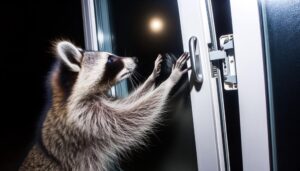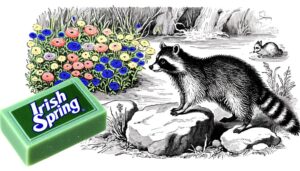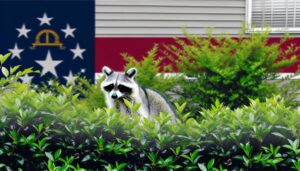Do Raccoons Poop in the Same Spot?
Raccoons do indeed defecate in the same spot, commonly referred to as latrine sites. These locations are typically elevated or secluded areas to minimize detection and are used by multiple raccoons over time.
Latrines serve not only for waste disposal but also as territorial markers and communication points. The accumulation of feces can present health risks due to parasites and diseases found in raccoon droppings.
Identifying these sites and understanding raccoon behavior can be essential for effective wildlife management. By exploring further, you can gain deeper insights into their habits and methods for managing their presence.
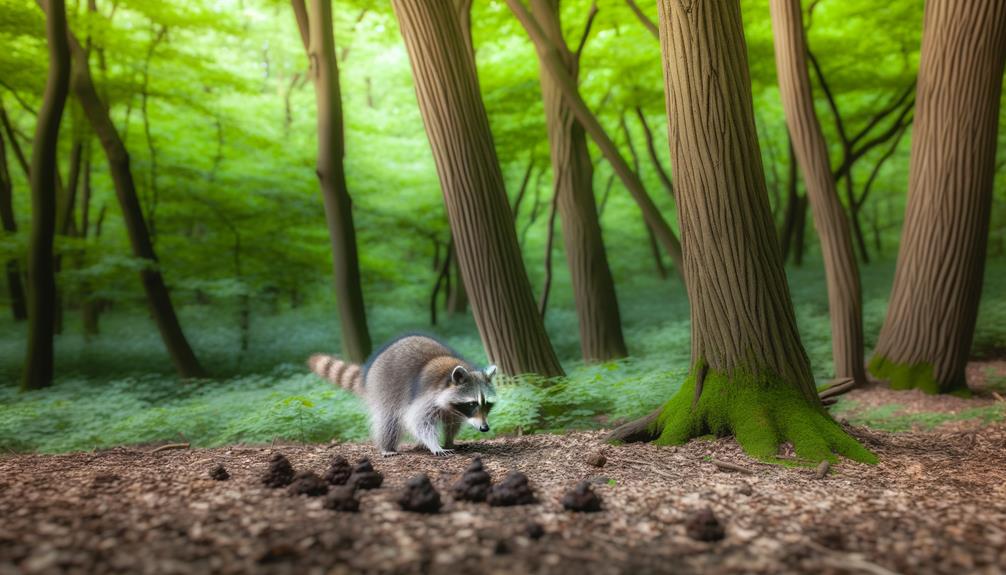
Key Takeaways
- Raccoons often use the same latrine sites repeatedly over time.
- Multiple raccoons may share the same latrine site.
- Latrine sites are chosen for being relatively undisturbed and sheltered.
- These sites serve as communication and territorial boundaries for raccoons.
- Elevated or secluded spots are preferred to minimize detection.
Raccoon Latrine Sites
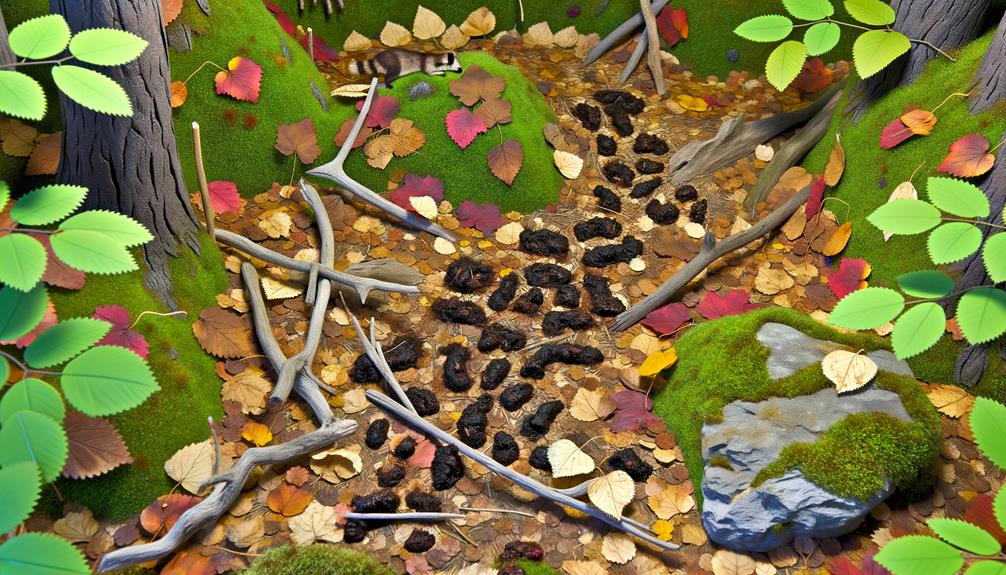
Raccoon latrine sites are specific locations where raccoons habitually defecate, often used repeatedly by multiple individuals over time. These sites are typically found in areas that provide shelter and are relatively undisturbed, such as the bases of trees, attics, or the tops of fences.
The fecal matter at these sites may accumulate significantly, posing health risks due to parasites like Baylisascaris procyonis, a roundworm that can infect humans and other animals. Detailed observation reveals that raccoons exhibit a preference for elevated or secluded spots, which may help in minimizing detection by predators.
Understanding the characteristics of raccoon latrine sites is essential for effective wildlife management and for mitigating potential health hazards associated with raccoon populations.
Territorial Marking Behavior
Territorial marking behavior in raccoons is closely tied to their use of latrine sites, which serve as both a means of communication and a method for establishing territorial boundaries.
The selection of these sites is strategic, often located in areas that maximize the spread of their scent markers to other raccoons.
This behavior highlights the dual purpose of latrines: facilitating social interactions and reinforcing territorial claims.
Scent Marking Purpose
Using scent marking as a form of communication, raccoons often deposit their feces in specific locations to establish and maintain territorial boundaries. This behavior serves multiple purposes, including deterring intruders and signaling the presence of a dominant individual. The following table illustrates key aspects of raccoon scent marking:
| Behavioral Aspect | Description |
|---|---|
| Purpose | Establishing territorial boundaries |
| Method | Deposition of feces |
| Frequency | Regular intervals |
| Communication Target | Other raccoons |
| Additional Marking Methods | Urine, scent glands |
Latrine Site Selection
In their territorial marking behavior, raccoons exhibit a preference for selecting specific latrine sites that are strategically located to maximize their communicative effectiveness. These latrines are often chosen based on their visibility and accessibility, ensuring that other raccoons and potential intruders can easily detect the scent markings.
The selection process is influenced by several factors:
- Elevation: Raccoons frequently choose elevated locations, such as logs or rock outcrops, to enhance the distribution of their scent.
- Proximity to resources: Sites near food sources or water bodies are preferred, as they are high-traffic areas.
- Cover and protection: Raccoons opt for latrine sites that offer some degree of cover, providing safety while they mark their territory.
These strategic choices underscore the importance of latrine sites in raccoon social structures.
Health Risks of Raccoon Feces
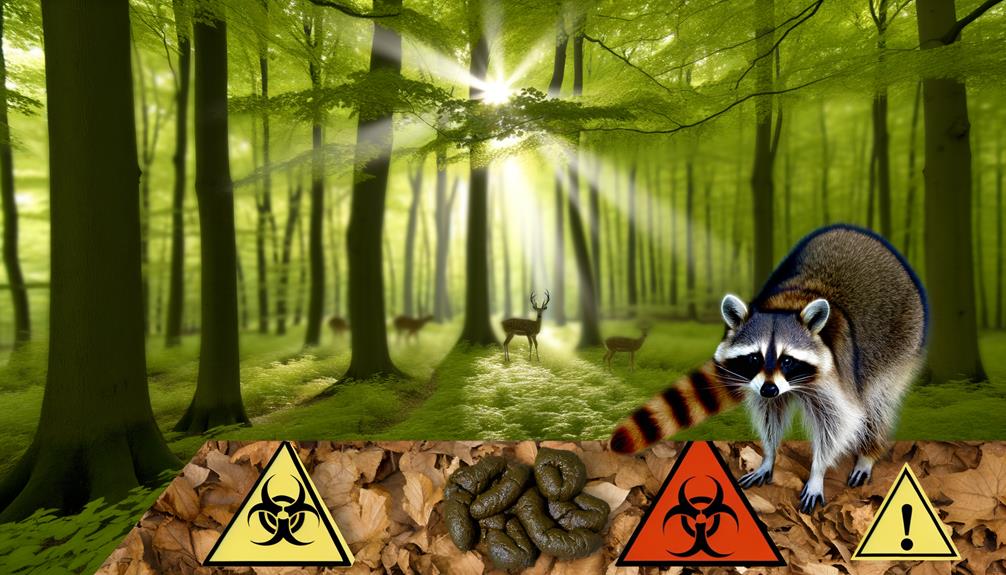
Raccoon feces pose significant health risks due to potential disease transmission and the presence of parasites such as Baylisascaris procyonis.
Infected feces can contaminate soil and water, posing a threat to both human and animal health.
Proper cleanup methods are essential to mitigate these risks and prevent the spread of infectious agents.
Disease Transmission Risks
The feces of raccoons pose significant health risks due to the potential transmission of various pathogens and parasites. These risks are heightened by the tendency of raccoons to defecate in communal latrines, where the accumulation of feces can facilitate disease spread. Human exposure to raccoon feces, either through direct contact or contamination of water and soil, can lead to severe health consequences.
- Leptospirosis: This bacterial infection can cause symptoms ranging from mild flu-like signs to severe liver and kidney damage.
- Salmonellosis: Caused by Salmonella bacteria, it leads to gastrointestinal distress, including diarrhea, fever, and abdominal cramps.
- Raccoon Roundworm (Baylisascaris procyonis): While detailed discussion will follow, this parasite poses significant neurological risks.
Understanding these risks underscores the importance of proper hygiene and preventive measures in areas frequented by raccoons.
Parasites in Feces
Fecal matter from raccoons harbors a variety of parasites, posing significant health risks to humans and other animals. The most notable among these is Baylisascaris procyonis, a roundworm whose eggs can be found in raccoon feces. When ingested, these eggs can hatch into larvae that migrate through the body, potentially causing severe neurological damage.
Additionally, raccoon feces may contain other parasites such as Giardia and Salmonella, both of which can lead to gastrointestinal issues. The environmental persistence of these parasites further exacerbates the risk, as eggs and cysts can remain infectious for extended periods.
Given these potential health hazards, it is essential to recognize the risks associated with raccoon feces and take appropriate preventative measures.
Proper Cleanup Methods
Given the significant health risks posed by the parasites in raccoon feces, proper cleanup methods are paramount for minimizing exposure and ensuring safety. Raccoon feces can harbor dangerous pathogens, including the Baylisascaris procyonis roundworm, which can cause severe neurological damage in humans. Therefore, meticulous and informed cleanup procedures are essential.
Personal Protective Equipment (PPE): Use gloves, masks, and protective clothing to prevent direct contact with feces and inhalation of airborne particles.
Disinfection: Apply an appropriate disinfectant to the affected area after feces removal to kill residual pathogens.
Safe Disposal: Seal the feces in a plastic bag and dispose of it in accordance with local hazardous waste regulations.
Adhering to these guidelines ensures effective and safe cleanup.
Identifying Raccoon Droppings
Identifying raccoon droppings requires careful observation of their size, shape, and content, which often include undigested food particles such as seeds and berries. Typically, raccoon feces are tubular, dark, and range from 2 to 3 inches in length. The presence of undigested material is an important indicator, reflecting the omnivorous diet of raccoons. Observing these characteristics can help distinguish raccoon droppings from those of other wildlife.
| Feature | Description | Notes |
|---|---|---|
| Size | 2 to 3 inches in length | Consistent size helps in identification |
| Shape | Tubular, often with blunt ends | Similar to small dog feces but distinguished by content |
| Color | Dark brown to black | Varies with diet |
| Content | Seeds, berries, and insect parts | Reflects raccoons' varied diet |
Understanding these features is essential for accurate identification and subsequent action.
Managing Raccoon Presence
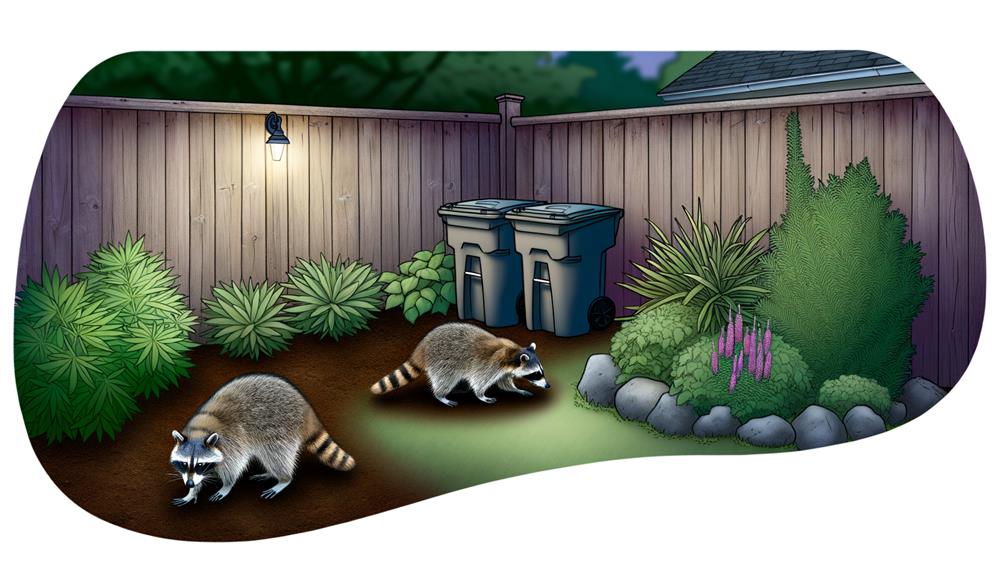
Effective management of raccoon presence requires a multifaceted approach that includes habitat modification, exclusion techniques, and deterrents.
First, reducing attractants such as accessible food and shelter can greatly decrease raccoon activity. Securing garbage bins and eliminating pet food sources are vital steps.
Second, exclusion methods like sealing entry points in buildings prevent raccoons from nesting in human habitats.
Finally, deterrents such as motion-activated lights or non-toxic repellents can deter raccoons from frequenting certain areas.
Habitat Modification: Eliminate food sources and potential nesting sites.
Exclusion Techniques: Seal entry points and install raccoon-proof barriers.
Deterrents: Utilize motion-activated lights and non-toxic repellents.
This all-encompassing strategy is crucial for effectively managing raccoon populations and reducing their impact on human environments.
Urban Raccoon Habits
Urban raccoon habits demonstrate a high degree of adaptability and resourcefulness, allowing these animals to thrive in densely populated human environments. They exhibit behaviors such as foraging in garbage, nesting in attics, and utilizing storm drains for travel. These behaviors underscore their opportunistic nature and ability to exploit urban resources.
| Behavior | Description | Impact on Humans |
|---|---|---|
| Foraging | Scavenging through trash bins | Increases litter and sanitation issues |
| Nesting | Creating dens in attics or chimneys | Potential property damage |
| Travel Routes | Using storm drains and sewers | Facilitates spread of diseases |
| Social Structure | Forming loose, adaptable social groups | Complex interactions with urban wildlife |
These habits are driven by the availability of food and shelter, illustrating their ecological flexibility.
Conclusion
Raccoons, akin to nature's meticulous scribes, often return to specific latrine sites, marking territories with a biological signature fraught with potential health hazards. Identifying these fecal deposits, rich with symbolic territorial claims, aids in understanding and managing raccoon presence, particularly in urban landscapes where their habits intersect with human activity.
Scientific scrutiny of these behaviors underscores the necessity for diligent observation and intervention to mitigate associated risks, thereby maintaining a balance within the shared environment.




